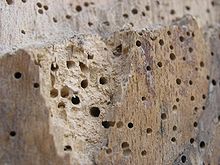Woodworm
The size of the holes varies, but they are typically 1 to 1.5 millimetres (5⁄128 to 1⁄16 in) in diameter for the most common household species, although they can be much larger in the case of the house longhorn beetle.They then pupate and hatch as beetles that then breed, lay eggs and repeat the process, causing further damage.However, some woodworm conditions, such as those caused by the waney edge borer (Ernobius mollis), require no treatment at all because the insect will have been killed in the preparation of the wood.Low-oxygen treatment is also effective but is costly and very time-consuming, taking as long as eight weeks to treat the problem.In places such as Cambodia, South Africa, the Philippines[5] and Papua New Guinea, woodworms may be considered edible delicacies.

Woodworm RecordsWormwoodcommon furniture beetleWoodboring beetlesAmbrosia beetlesweevilsScolytinaePlatypodinaePentarthrum huttoniEuophryum confineBark borer beetleDeathwatch beetleHouse longhorn beetlePowderpost beetleWharf borerpupatewoodboring weevilErnobius mollisCambodiaSouth AfricaPhilippinesPapua New GuineaBookworm (insect)List of common household pestsPtinidaeShipwormWoodboring beetleYouTube